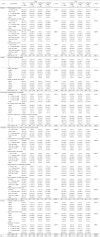3. Chung IJ, Park JY, Kim EY. Factors predicting suicidal ideation and suicidal attempts of school youth and out-of-school youth. Ment Health Soc Work. 2010; 34(1):222–251.
5. Ministry of Education (KR). Ministry of health and welfare, Korea Centers for Disease Control & Prevention. The 14th Korea youth risk behavior web-based survey. Sejong: Ministry of Education;2018.
6. Nam KM. Effect of healthy school tuck shop on snack preference and dietary behavior among adolescent [dissertation]. Seoul: Hanyang University;2012.
7. Cho YJ, Kim MH, Kim MH, Choi MK. Night eating habits of middle school students in Gyeonggi. J Korean Soc Food Sci Nutr. 2014; 43(2):300–308.

8. Pae M. Dietary habits and perception toward food additives according to the frequency of consumption of convenience food at convenience stores among university students in Cheongju. Korean J Community Nutr. 2016; 21(2):140–151.

9. Shin GN, Kim YR, Kim MH. Nutritional evaluation of convenience meals in convenience stores near the universities. Korean J Community Nutr. 2017; 22(5):375–386.

10. Marshall S, Burrows T, Collins CE. Systematic review of diet quality indices and their associations with health-related outcomes in children and adolescents. J Hum Nutr Diet. 2014; 27(6):577–598.

11. Kim HY, Lee JS, Hwang JY, Kwon SH, Chung HR, Kwak TK, et al. Development of NQ-A, nutrition quotient for Korean adolescents, to assess dietary quality and food behavior. J Nutr Health. 2017; 50(2):142–157.

12. Kim HY, Kwon SH, Lee JS, Choi YS, Chung HR, Kwak TK, et al. Development of a nutrition quotient (NQ) equation modeling for children and the evaluation of its construct validity. Korean J Nutr. 2012; 45(4):390–399.

13. Chung MJ, Kwak TK, Kim HY, Kang MH, Lee JS, Chung HR, et al. Development of NQ-E, nutrition quotient for Korean elderly: item selection and validation of factor structure. J Nutr Health. 2018; 51(1):87–102.

14. Kim HY, Jeong SJ. Dietary behavior of college students in Kangreung area on convenience food. Korean J Soc Food Cookery Sci. 2002; 18(4):440–447.
15. Kim MH, Bae YJ, Lee HJ, Choi MK. The evaluation of nutritional knowledge and dietary habits according to sex and mother's employment status in middle school students. J East Asian Soc Diet Life. 2009; 19(6):921–927.
16. Bae YK, Kim YN. Fast foods intake of highschool students in Daejeon area. J Korean Home Econ Educ Assoc. 2016; 28(2):41–50.
17. Lee SK, Choi MK, Kim MH. Study on middle and high school students' use of convenience foods at convenience stores in Incheon. Korean J Community Nutr. 2019; 24(2):137–151.

18. Jung HK, Jo HJ, Choi MJ. A study on vegetable & fruit eating habits and dietary fiber intake of high school students-focusing on high school students in Daegu. J Korean Soc Sch Health Educ. 2011; 12(3):43–64.
19. Lee KA, Cho EJ, Yoon HS. A study on consumption of convenience foods of university students by residing types in Changwon and Masan area. J Korean Diet Assoc. 2010; 16(3):279–290.
20. Jeong KJ, Lee JH, Kim MH. A study on the nutrition knowledge, dietary behaviors, and dietary habits according to the gender in high school students in Chungnam area. Korean J Food Nutr. 2014; 27(3):458–469.

21. Koo HJ, Kim SY. Analysis of purchasing behaviors of processed foods in high school students in Yongin region. J Korean Soc Food Sci Nutr. 2014; 43(12):1929–1936.

22. Lee JH, Lee EH, Choi E. Study on eating habits and food preference for breakfast of elementary, middle, or high school students in the Incheon area. Korean J Food Cookery Sci. 2014; 30(2):170–182.

23. Choi KI. An effect on body image of time of television watching and internet use for academic high school students. J Adolesc Welf. 2013; 15(3):173–191.
24. Jung SY. Effects of maternal employment on adolescents' overweight and obesity. J Korean Soc Child Welf. 2013; 41:39–66.
25. Boynton-Jarrett R, Thomas TN, Peterson KE, Wiecha J, Sobol AM, Gortmaker SL. Impact of television viewing patterns on fruit and vegetable consumption among adolescents. Pediatrics. 2003; 112(6 Pt 1):1321–1326.

26. Kim KH. A study of the dietary habits, the nutritional knowledge and the consumption patterns of convenience foods of university students in the Gwangju area. Korean J Community Nutr. 2003; 8(2):181–191.
27. Jung EY, Lim YH, Park MS, Kim MW. A survey of the consumption of convenience foods. Korean J Community Nutr. 2002; 7(2):149–155.
28. Jang HS. A study of the dietary habits, the nutritional knowledge and the consumption patterns of convenience foods of high school students. Secondary Educ Res. 2004; 52(1):453–468.
29. Kim EJ, Kim KN. Night snack consumption among high school students in Cheongju. J Hum Ecol. 2013; 17(2):57–67.
30. Park IJ, Park YW. Survey on intake of snacks and self-purchased snacks due to lack of sleep in high school students in Gwangju. Korean J Food Cult. 2009; 24(3):256–266.
31. Kim YJ, Jeon ER, Yoo MJ, Jung LH. Perception and utilization of food labeling system of middle school students in Gwangju. J Korean Soc Food Sci Nutr. 2012; 41(6):796–806.








 PDF
PDF ePub
ePub Citation
Citation Print
Print




 XML Download
XML Download